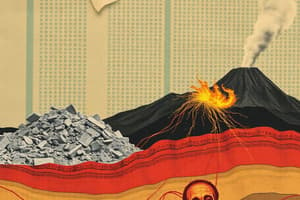Podcast
Questions and Answers
What geological process is responsible for the formation of new crust at divergent boundaries?
What geological process is responsible for the formation of new crust at divergent boundaries?
- Magma cooling and rising from the mantle (correct)
- Volcanic eruptions
- Earthquakes
- Plate collision
Which geological feature forms due to the plate interaction at the Mid-Atlantic Ridge?
Which geological feature forms due to the plate interaction at the Mid-Atlantic Ridge?
- Andes Volcanic Chain
- Great Rift Valley
- Caribbean Plate (correct)
- Himalayan Mountains
Where is the San Andreas Fault located, known for its seismic activities?
Where is the San Andreas Fault located, known for its seismic activities?
- California (correct)
- Alaska
- Hawaii
- Japan
What type of boundary is characterized by plates moving away from each other?
What type of boundary is characterized by plates moving away from each other?
Which geological event is primarily associated with transform boundaries?
Which geological event is primarily associated with transform boundaries?
How do seismic activities contribute to shaping Earth's surface?
How do seismic activities contribute to shaping Earth's surface?
What geological features can be formed at convergent plate boundaries?
What geological features can be formed at convergent plate boundaries?
Where does magma come from in volcanic eruptions at convergent boundaries?
Where does magma come from in volcanic eruptions at convergent boundaries?
Which geological event is associated with subduction zones?
Which geological event is associated with subduction zones?
In which region can we find the Cascade Range built by the mechanism of one plate forced under the other?
In which region can we find the Cascade Range built by the mechanism of one plate forced under the other?
What type of plate motion occurs at oceanic ridges?
What type of plate motion occurs at oceanic ridges?
Which feature is NOT commonly associated with subduction zones?
Which feature is NOT commonly associated with subduction zones?
Flashcards are hidden until you start studying
Study Notes
Plate Tectonics and Volcanic Eruptions
Plate tectonics is a scientific theory explaining the movement of Earth's crust and upper mantle. This process involves three main types of plate boundaries: convergent, divergent, and transform. Each type of boundary has its unique characteristics and consequences, including the formation of various geological features such as mountains, volcanoes, and seismic activities like earthquakes. In this section, we will discuss how these phenomena relate to plate tectonics.
Convergent Boundaries and Volcanic Eruptions
Convergent boundaries occur where two plates collide and either get forced under each other (subduction) or above each other to form a large mountain range. At these boundaries, intense heat and pressure cause magma to rise from deep within Earth, creating volcanic eruptions. For example, the Cascade Range in the Pacific Northwest of the United States is built by this mechanism.
Subduction Zones and Oceanic Ridges
Subduction zones form when one oceanic plate moves beneath another, and they are often associated with volcanic arcs. An example of this can be seen along the western coast of South America, where the Nazca Plate dips below the South American Plate, forming a portion of the Andes Mountains. Similarly, the Aleutian Islands off Alaska and Japan's Izu Peninsula show similar features, which also host active volcanoes.
Divergent Boundaries and Seafloor Spreading
Divergent boundaries occur where plates move away from each other, allowing magma from the mantle to rise up and cool, forming new crust. This process is called seafloor spreading and occurs at ridges such as the Mid-Atlantic Ridge and the East Pacific Rise. The process of seafloor spreading also produces volcanic eruptions, such as those along the Mid-Atlantic Ridge, which forms the Caribbean Plate and the North American Plate.
Transform Boundaries and Seismic Activities
Transform boundaries occur where plates slide past each other. These types of boundaries are also associated with seismic activities, including earthquakes. A well-known example of a transform boundary is the San Andreas Fault in California, where the Pacific Plate is sliding past the North American Plate, causing earthquakes.
In summary, plate tectonics plays a crucial role in shaping Earth's surface and producing various geological features. Volcanic eruptions, earthquakes, and other geological activities are the result of plate interactions, which are characterized by three main types of boundaries: convergent, divergent, and transform. Understanding these processes helps us better comprehend the dynamic nature of our planet and the mechanisms that create its diverse landscapes.
Studying That Suits You
Use AI to generate personalized quizzes and flashcards to suit your learning preferences.



